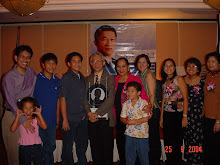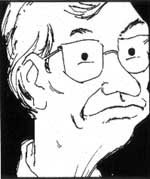MarketingRx for Feb 05-10
"The Marketing of Noynoy, Manny and Gibo" - Part 1
By Dr Ned Roberto & Ardy Roberto
Q: We are another NGO who is unlike the ones who have been asking you to apply your social marketing in analyzing the coming presidential election.
First of all, we DO NOT believe marketing or social marketing should further confuse what's already a confusing political scenario preparing for a critical point in this nation's history. We think calling this manipulative practice of marketing as social marketing won't absolve the practice of its Machiavellian character.
We say you are confusing the voting public by calling their coming voting behavior as "low involvement behavior." How can you say that when you know that this coming election is all about this country's next six years as continuing misery or as misery reversal? Isn't it a fundamental truth in education that if you tell a child that he's useless, he will henceforth behave as if he's useless? That's the same with voters. Tell them this election is low involvement and they will so regard it. (Please keep out of politics and social science--just stay in marketing.) - Mr Confidential
A: WE APPRECIATE YOUR frankness. We should be just as frank to tell you that we cannot say the same about how "politically correct" you delivered them. Allow us to respond to each of the two major points of your note.
We start with the easiest, namely, your equating marketing with social marketing. Even such grant-giving global foundations from whom most high performing and more reputable NGOs obtain their funding support, have since more than 20 years ago recognized social marketing's insightful contributions. In fact, most now require social and economic projects to integrate social marketing into their interventions. These are global foundations like those in Japan, U.S., Canada and Europe. If this is unknown to you, then it's unfortunate that you have allowed your knowledge of marketing and social marketing to remain in the vintage of 50s and 60s. A little updating will do your mindset some good and lessen your distrust and understandable indignation over marketing's checkered past.
Low involvement
Your second point challenges our inference that the voting behavior in this coming election is low involvement. That conclusion draws from the survey data from both SWS and Pulse-Asia. When probed as to why they will vote so-and-so candidate, most Class D (borderline poor) and Class E (extreme poor) voters say something like this one who was the more articulate of those interviewed: "Sa totoo lang, para sakin parepareho lang lahat yang mga kandidatong yang. Simula pa ke Cory, wala namang kahit isang presidentena nakapag ahon samin ni kaunti sa kahirapan." (Truly, for me these candidates are all the same. Starting with Cory, not a single president has brought us even a little bit out of poverty.)
Some of the voting poor had also been heard to say in answer to the question of how important to them is this coming election: "Ano ba naman ang gagawin namin sa darating na election? Sa totoo lang, yan naman ay limang minuto sa isang araw sa anim na taon sa aming buhay na pagkatapos niya ay magkakalimutan na uli tayo." (What do we have to do in this coming election? In truth, that's just five minutes in one day within 6 years in our life, after which we're back to forgetting each other.) Is this kind of attitude that you would count as correlated with high involvement?
All these are said out of the past 20 or more years of experience of the vast population of the poor with what they saw our past 4 presidents had done (or rather had not done) for them and their poverty. And remember that A.C. Nielsen estimates the poor to now account for 90% of our total nationwide population!
You are probably correct in thinking that voting behavior among the poor was once high involvement. That must have been during Cory's term. But thereafter especially with the last two administrations, it had come to what our quoted verbatims from the interviewed poor implied. For the great majority of the poor, voting in the coming election doesn't matter anymore. This explains why before Cory died, all leading 4 to 5 presidential candidates were very close to one another in their respective shares of votes.
We are out of space, so get your copy of the Inquirer next Friday to read the conclusion and discover why Villar is catching up with Noynoy (and what Noynoy can do about this) and why Gibo's advertising is keeping him from advancing in the polls.
Keep your questions coming. Send them to us at drnedmarketingRx@gmail.com or marketingrx@pldtdsl.net . God bless!
~~~~~~~~~~~~~~~~~~~
MarketingRx for Feb 12-010
"The Marketing of Noynoy, Manny and Gibo" - Part 2
By Dr Ned Roberto & Ardy Roberto
Many of us thought that after Cory died and when suddenly Noynoy out of nowhere registered a 50% share of votes, most voters' low involvement just as suddenly transformed into high involvement. That was more out of a sense of hope that took over our more scientific reading of the survey statistics.
We were brought back to the hard reality of the poor voters as the literature on low involvement in consumer behavior research predicted. Low involvement voters like low involvement consumers behave according to the dictates of what's on top-of-mind and/or what's on top-of-heart. What they are aware of and what draws and holds their attention drives their purchase behavior or in the present discussion their voting intention behavior registered in the SWS and Pulse-Asia surveys as a candidate's share of votes.
Explaining Villar's Rise
And those are exactly the voter responses that Manny Villar's advertising concentrated on generating: voter top-of-mind awareness and top-of-heart attention-drawing and attention-holding among both borderline poor and extreme poor voters. These quickly translated in the last survey into an increase of Villar's share of votes from 24% to 33% to last month's 35%. That's not at all that far from Noynoy's slowly falling 44% share of votes and last month's 42% especially when you factor in the two ratios' respective margin of error.
Single-mindedness.Another notable characteristic of low involvement behavior is how it is influenced by "single-minded" message. It is easily confused by a communication message with "multiple claims." Just consider how single-mindedness is the very essence of Villar's advertisement. Contrast that to the Noynoy TV ad promising more than half a dozen "evils" to fight against and ending with a promise never to steal and be corrupt. To the upper and middle class (which according to the latest estimate from A.C.Nielsen makes up only 8% to 10% of total Philippine population) this may be a top priority election concern and issue. But to the 90% poor, according to the SWS and Pulse-Asia surveys, this ranks as a low #7 priority election issue. And you don't need space science to appreciate how Villar's recent use of Dolphy (an icon with the poor) is going to be a real knock-out. Of course, we'll have to wait for this month's survey to confirm or disconfirm. But in all these, which candidate do you think will resonate more with the vast majority of the voting poor and be their top-of-mind and top-of-heart presidential choice?
Gibo, the pilot?
Gibo's advertising message and execution inside an airplane that he's piloting is even more alien and most likely alienating to the poverty voters. How many percent of the poor had ever seen the inside of a plane or the inside of the plane's pilot cockpit? Talk of the significance of having an ad with high identification with its target audience and you'll have to give a really low failing grade to Gibo's TV commercial.
Our reading of low involvement in the poor voters' regard for their voting behavior in the coming election is not an opinion. It's drawn from solid and valid survey based data. It's your assumption that because for you "this coming election is all about this country's future," then it must be so with the rest of the voters in the country including the 90% poor. Just because you yourself are a voter does not mean what is high involvement to you and your NGO is also high involvement to the poor. Learn to acquire EQ (Empathy Quotient) for the poor and you'll become of more help to them and more understanding of those outside your more noble profession.
What to do now, Noynoy and Gibo?
Please do not think that our analysis is an endorsement of Villar. The same analysis benefits the other two candidates, Noynoy and Gibo if they are to ask: "So what do we do now?" To Noynoy our low involvement analysis says clearly: "Stop the bleeding of your share of votes. Consider what the low-involvement concept prescribes for you especially in your advertisement. Stop promising too many things. Do a Villar and be single minded." And to Gibo? At this point, social marketing does not know what to tell him to do but it knows what to tell him he should not do. Stop executing your TV commercials in a context that has low-identification value to the poor voters.
Keep your questions coming. Send them to us at drnedmarketingRx@gmail.com or marketingrx@pldtdsl.net . God bless!









